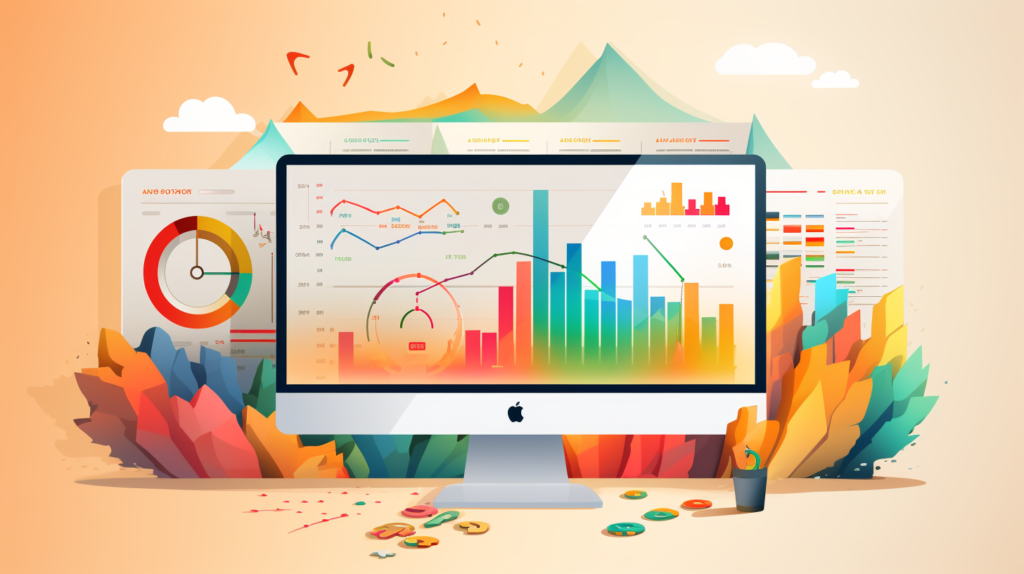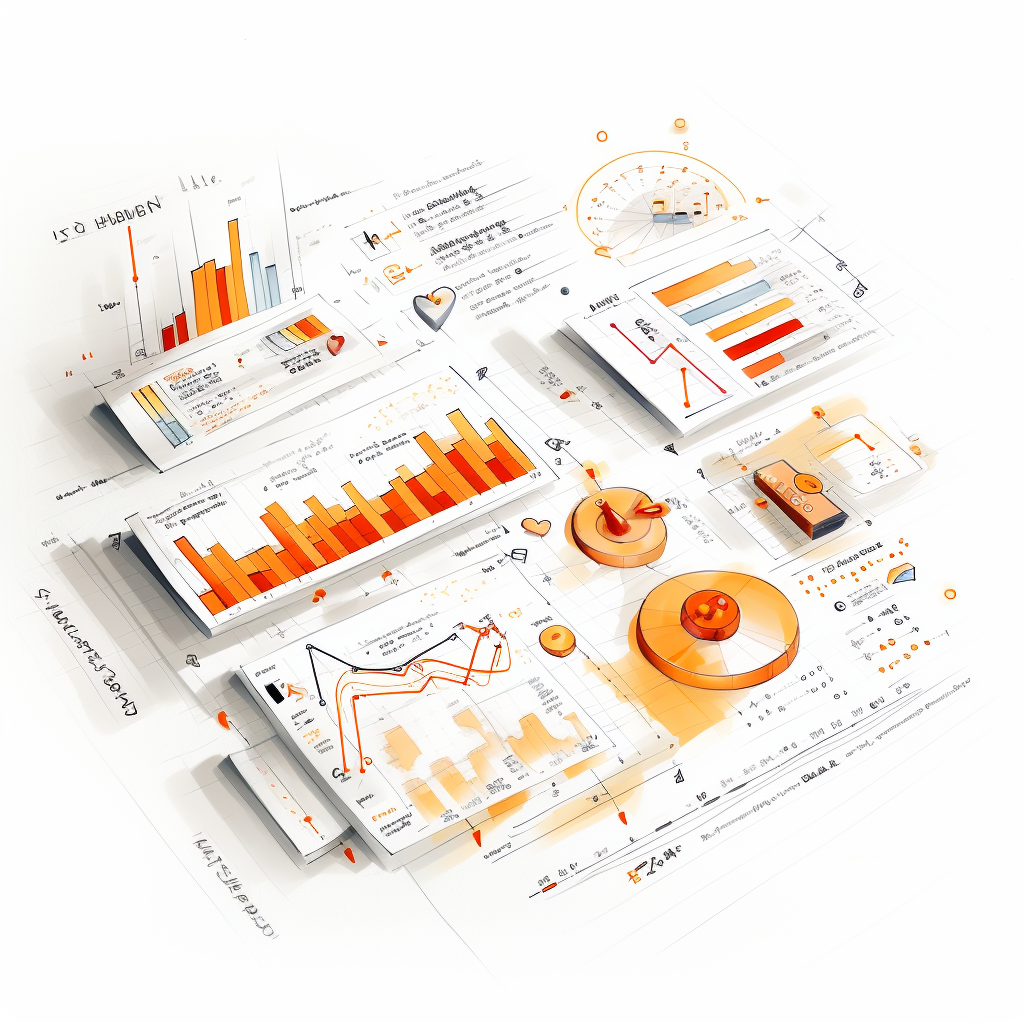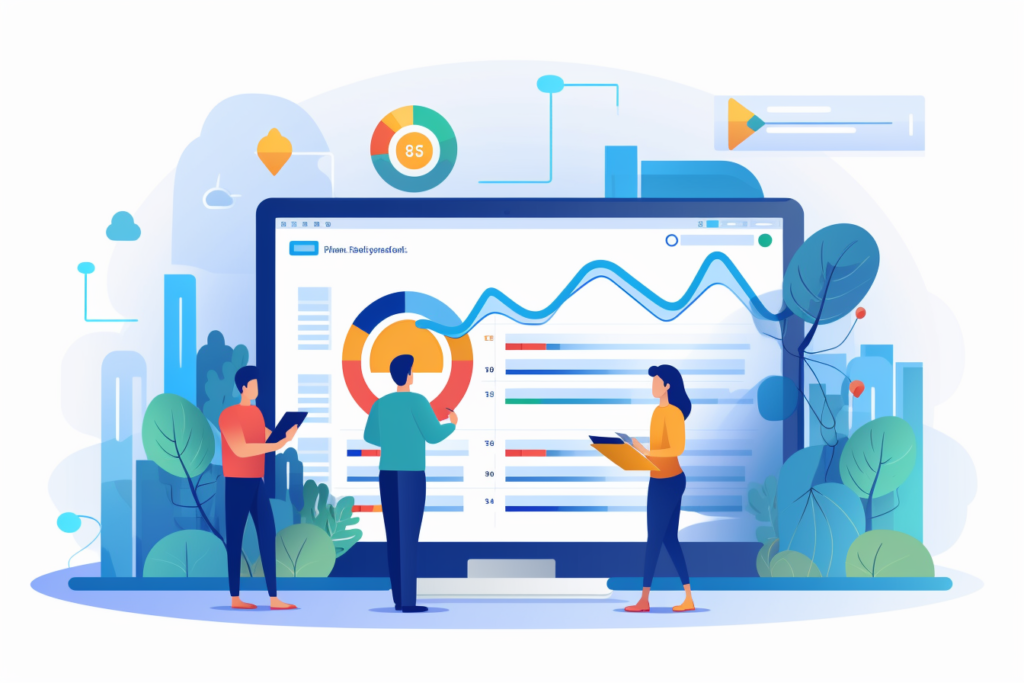
In today’s digital-driven business landscape, understanding and leveraging web analytics is not just an advantage; it’s a necessity. “Monthly Guide to Google Analytics for Medium-Sized Businesses” is crafted to demystify the complexities of Google Analytics, making it accessible and actionable for business owners and website managers. This guide takes you on a journey through the intricacies of Google Analytics, providing you with the knowledge and tools needed to turn data into insightful, strategic decisions. Tailored for medium-sized businesses, this guide recognises the unique challenges and opportunities that lie in interpreting web data, aiming to empower businesses with the proficiency to navigate their digital footprint effectively.
Each month, your website generates a wealth of data that, if harnessed correctly, can unlock profound insights into customer behaviour, marketing effectiveness, and overall business performance. From setting up your Google Analytics account to diving into advanced features, this guide breaks down the process into manageable, monthly tasks. We’ll explore crucial terminologies, interpret key metrics, and guide you through reading various reports, all while avoiding common pitfalls. Real-world case studies will provide context, showing how similar businesses have successfully applied these insights. Whether you’re new to Google Analytics or looking to deepen your understanding, this guide serves as your compass in the vast ocean of data analytics.
Chapter 1: Setting Up Google Analytics

Learn the fundamental steps of setting up Google Analytics for your website, ensuring accurate data collection and a solid foundation for analysis.
Getting Started with Google Analytics
The foundation of using Google Analytics effectively begins with proper setup. This chapter guides you through creating your Google Analytics account, setting up a property for your website, and ensuring that you’re ready to start collecting valuable data.
Step 1: Creating a Google Analytics Account
- Navigate to Google Analytics: Visit the Google Analytics website. If you already have a Google account (such as Gmail), you can use it to sign in. Otherwise, you’ll need to create a new Google account.
- Sign Up for Google Analytics: Once logged in with your Google account, look for the option to sign up for Google Analytics. Follow the prompts to start the setup process.
Step 2: Setting Up a Property
- Creating a New Property: In Google Analytics, a ‘property’ refers to your website or app. Click on ‘Admin’ at the bottom left of your screen, and then select ‘Create Property.’
- Enter Your Website Details: Provide the necessary information like your website name, URL, and the industry category that best describes your business. This information helps Google Analytics to customise your data tracking.
Step 3: Adding Tracking Code
- Obtaining the Tracking ID: After creating a property, you will be given a unique tracking ID and a JavaScript tracking code. This code needs to be installed on every page of your website.
- Installing the Code: The tracking code should be placed in the header section of your website’s HTML. If you’re using a website builder or a content management system like WordPress, look for options to add custom scripts or use a plugin designed for Google Analytics integration.
Step 4: Configuring Settings
- Adjusting Data Sharing Settings: Decide how much data you want to share with Google and other services. This can be done in the ‘Account Settings’ section.
- Setting Up Views: Views allow you to create specific perspectives of your data, like filtering out internal traffic. Go to the ‘View’ column and set up a new view, then configure filters as needed.
Step 5: Verifying Setup
- Checking Installation: To ensure that the tracking code is installed correctly, visit your website and then check the Real-Time report in Google Analytics. If your visit is recorded, the setup is successful.
- Data Consistency: Browse through different pages of your site and verify that all pages are being tracked.
Important Tips:
- Double-Check Implementation: Make sure that the tracking code is consistently implemented across all pages of your site to ensure complete data collection.
- Consider Google Tag Manager: For more advanced tracking (like event tracking), consider using Google Tag Manager. It simplifies the process of managing various tags on your website without needing to edit code directly.
This chapter sets up the fundamental structure of Google Analytics on your website. It’s crucial to get this setup right, as accurate data collection is the backbone of your analytics insights. Once set up, you can dive into understanding and utilising the wealth of information that Google Analytics provides.
Chapter 2: Understanding the Google Analytics Dashboard

Navigate the Google Analytics dashboard with ease, understanding each component – Real-Time, Audience, Acquisition, Behaviour, and Conversions – for a comprehensive view of your website’s performance.
Navigating the Heart of Google Analytics
The Google Analytics dashboard is where you’ll spend most of your time analyzing data and extracting actionable insights. This chapter will guide you through the main components of the dashboard, helping you understand what information is available and how to access it effectively.
Dashboard Overview
When you first log into Google Analytics, you’ll be greeted by the dashboard. This is your overview screen where you can quickly access a wealth of data about your website’s performance.
- Real-Time:
- This section shows what is happening on your site at this very moment. It’s useful for monitoring immediate effects of new content or campaigns.
- Audience:
- Here you’ll find information about your visitors, such as demographics, interests, geography, and behavior. Understanding your audience helps in tailoring content and marketing strategies.
- Acquisition:
- This area tells you how your visitors are finding your website. It breaks down traffic sources into categories like organic search, paid search, social, and direct.
- Behaviour: This section provides data on what visitors do once they’re on your site. It includes pages they visit, how long they stay, and what actions they take.
- Conversions:
- If you’ve set up goals (like form submissions or product purchases), this is where you’ll track their performance. It’s crucial for evaluating the effectiveness of your website in meeting business objectives.
Customising the Dashboard
To make the most of the dashboard, you can customise it to show the data that’s most relevant to your business needs.
- Adding Widgets: You can add various widgets to your dashboard for a quick view of key metrics. These can be tables, pie charts, graphs, and more.
- Creating Custom Reports: Google Analytics allows you to create custom reports. This means you can focus on specific data points that are most relevant to your business.
Navigating the Interface
- Familiarise yourself with the layout. The main menu on the left-hand side is your primary navigation tool.
- Use the date range selector at the top right to view data from specific time periods.
- Explore different tabs within each section for more detailed insights.
Utilising the Dashboard for Monthly Reviews
For monthly analytics reviews:
- Focus on comparing current data with the previous month to identify trends and changes.
- Pay special attention to any spikes or drops in key metrics and investigate their causes.
- Use the Audience Overview report to see if there are any significant changes in your audience demographics or behavior.
- Check Acquisition reports to see how changes in your marketing strategies are affecting traffic sources.
- Review Behaviour reports to understand how updates to your website are impacting user interaction.
- Analyse Conversion data to see if you’re effectively meeting your set goals and objectives.
This chapter equips you with the knowledge to navigate and utilise the Google Analytics dashboard effectively, turning raw data into actionable insights. Understanding these fundamental aspects of the dashboard is key to making the most out of your monthly data analysis.
Chapter 3: Key Terminologies Explained

Demystify the essential terms in Google Analytics, like sessions, users, pageviews, bounce rate, and conversion rate, crucial for interpreting your data accurately.
Decoding Google Analytics Jargon
Google Analytics is full of specific terms and jargon that can be overwhelming. Understanding these terms is crucial for interpreting your data accurately. This chapter breaks down the most important terms you’ll encounter.
1. Sessions
- Definition: A session is a group of user interactions with your website that take place within a given time frame. A single session can contain multiple page views, events, social interactions, and e-commerce transactions.
- Importance: Sessions provide a window into the user’s journey on your site. Tracking the number of sessions can help you understand the level of engagement with your site.
2. Users
- Definition: Users are individuals who have initiated at least one session on your website. Google Analytics differentiates between ‘new’ and ‘returning’ users.
- Importance: Understanding your user base, including how many are new versus returning, can help tailor your content and marketing strategies.
3. Pageviews
- Definition: A pageview is recorded every time a user views a page on your site. Multiple pageviews can occur during a single session.
- Importance: Pageviews give you an idea of which pages are most popular and engaging on your website.
4. Bounce Rate
- Definition: The bounce rate is the percentage of sessions where the user left your site from the entrance page without interacting with the page.
- Importance: A high bounce rate might indicate that the page isn’t engaging or relevant to visitors, or that the user found what they needed without needing to navigate further.
5. Conversion Rate
- Definition: Conversion rate is the percentage of sessions that result in a conversion. Conversions can be defined as any key action you want users to take, such as making a purchase, signing up for a newsletter, or filling out a contact form.
- Importance: This metric is crucial for understanding the effectiveness of your site in encouraging users to take a specific action.
6. Acquisition
- Definition: Acquisition refers to how you acquire users. It includes channels such as organic search, direct traffic, social media, referrals, and paid search.
- Importance: Knowing where your users come from helps you understand which of your marketing efforts are most effective.
7. Behaviour
- Definition: Behaviour metrics provide insight into how users interact with your website, including what pages they visit, what actions they take, and how long they stay on a page.
- Importance: This information is essential for optimising the user experience on your website.
8. Goals
- Definition: Goals are specific actions you want users to complete. They can be set up in Google Analytics to track conversions.
- Importance: Goals help you measure how well your site fulfils your target objectives.
Understanding these terms will make navigating through Google Analytics reports more intuitive and the data more meaningful. This foundational knowledge is key to effectively analysing and leveraging the information Google Analytics provides.
Chapter 4: Important Metrics to Monitor Each Month

Focus on critical metrics such as traffic sources, user engagement, conversion rates, and mobile traffic, essential for monthly performance reviews and strategic planning.
Essential Google Analytics Metrics for Monthly Review
Regular monitoring of certain key metrics in Google Analytics can provide profound insights into your website’s performance and user behaviour. This chapter outlines the most critical metrics you should review each month to gauge your site’s effectiveness.
1. Traffic Sources
- Why It Matters: Understanding where your traffic comes from (organic search, direct, social media, referrals, or paid search) helps you determine which marketing efforts are paying off.
- Monthly Review: Look for shifts in traffic sources and correlate these with your marketing activities. An increase in organic search, for example, might indicate improved SEO.
2. User Engagement
- Metrics to Monitor: Average session duration and pages per session.
- Why They Matter: These metrics indicate how engaged users are with your content. Longer session durations and more pages per session typically signify higher engagement.
- Monthly Review: Look for trends and changes in these metrics, and consider what content or changes might be influencing them.
3. Conversion Rates
- Why It Matters: The conversion rate shows the effectiveness of your site in encouraging visitors to take desired actions, such as making purchases or signing up for newsletters.
- Monthly Review: Analyse how conversion rates change over time and identify factors that might influence these changes, like new content or website updates.
4. Bounce Rate
- Why It Matters: Bounce rate can be an indicator of the relevance and quality of your landing pages.
- Monthly Review: High bounce rates on certain pages might indicate issues with content or user experience. Investigate and consider A/B testing to improve these pages.
5. Mobile Traffic
- Why It Matters: With increasing mobile internet usage, understanding how your site performs on mobile devices is essential.
- Monthly Review: Monitor the proportion of traffic from mobile devices and the performance metrics for these users. Ensure your site is optimised for mobile to provide a good user experience.
6. Site Content Performance
- Metrics to Monitor: Pageviews, unique pageviews, and time on page.
- Why They Matter: These metrics help you understand which pages are most popular and engaging.
- Monthly Review: Identify your top-performing content and understand what makes it successful. Use these insights to guide your content strategy.
7. Goals and E-commerce Performance (if applicable)
- Why It Matters: For sites with specific goals or e-commerce functionality, tracking these metrics is crucial for understanding business performance.
- Monthly Review: Review goal completions and e-commerce conversion rates to assess the effectiveness of your site in driving business outcomes.
These metrics offer a comprehensive view of your website’s performance and user behaviour. By consistently reviewing them each month, you can identify trends, make informed decisions, and adapt your strategies for better results.
Do you require SEO services?
Read our latest blog on our new Blogging website

Chapter 5: Reading Reports in Google Analytics

Master the art of reading and interpreting different types of reports – Audience, Acquisition, Behaviour, Conversion – turning data into actionable insights.
Interpreting Data for Business Insights
One of the most valuable aspects of Google Analytics is its ability to generate detailed reports. Understanding how to read and interpret these reports is crucial for extracting meaningful insights. This chapter will guide you through the major types of reports available in Google Analytics and how to use them for your business advantage.
1. Audience Reports
- Purpose: These reports provide insights into the characteristics of your website visitors, including demographics, interests, location, and technology used.
- Key Features: Age, gender, interests, geo-location, behaviour, technology (devices and browsers used).
- How to Use: Use these insights to tailor your content and marketing strategies to your audience’s preferences and behaviours.
2. Acquisition Reports
- Purpose: Acquisition reports show you how visitors arrive at your site and the effectiveness of your acquisition strategies.
- Key Features: Channels (organic search, direct, referral, social, paid search), campaigns, keywords.
- How to Use: Identify which channels are driving the most valuable traffic and adjust your marketing strategies accordingly.
3. Behaviour Reports
- Purpose: These reports help you understand what visitors do on your site.
- Key Features: Site content (most visited pages), landing pages, exit pages, site speed, events.
- How to Use: Analyse which content keeps users engaged, identify potential issues with specific pages (like high exit rates), and optimise for better user experience.
4. Conversion Reports
- Purpose: Conversion reports are vital for tracking the effectiveness of your website in achieving set goals.
- Key Features: Goals overview, goal URLs, funnel visualisation, e-commerce (if set up).
- How to Use: Monitor how well you’re meeting your business objectives and identify areas for improvement.
5. Custom Reports
- Purpose: Custom reports allow you to create reports tailored to your specific needs.
- How to Use: Combine various dimensions and metrics that are most relevant to your business for a personalised view of your data.
Utilising Reports for Monthly Reviews
For your monthly analytics reviews:
- Compare the current month’s data with the previous month and the same month in the previous year to identify trends.
- Look for any significant changes in user behaviour, traffic sources, or conversions and investigate their causes.
- Use audience insights to refine your target market profiles.
- Evaluate the effectiveness of your content and marketing strategies based on behaviour and acquisition data.
- Assess the achievement of your business goals and adjust your strategies where necessary.
Understanding and utilising these reports effectively will enable you to gain deeper insights into your website’s performance and user behaviour, aiding in making informed decisions for your business.
Chapter 6: Making Data-Driven Decisions

Utilise Google Analytics data to inform and refine your business strategy, enhancing marketing efforts, improving user experience, and optimising conversions.
Utilising Analytics to Inform Business Strategy
The ultimate goal of using Google Analytics is to make informed decisions that drive your business forward. This chapter explores how to translate the data and insights from Google Analytics into actionable strategies that can improve your website’s performance and overall business success.
1. Applying Data Insights to Marketing Strategies
- Analyse Traffic Sources: Determine which marketing channels are most effective and allocate resources accordingly.
- Campaign Performance: Evaluate the success of specific marketing campaigns and understand user response to different marketing efforts.
- Content Strategy: Use pageview data and user engagement metrics to inform your content strategy, focusing on what works best for your audience.
2. Enhancing User Experience
- Website Navigation: Understand how users navigate through your site. Identify common paths and any potential barriers to smooth navigation.
- Page Performance: Identify which pages perform well and which don’t. Use this information to optimise underperforming pages.
- A/B Testing: Use data to inform A/B tests, experimenting with different versions of a page to see which performs better.
3. Conversion Optimisation
- Goal Tracking: Regularly review your goal performance and identify areas where users drop off.
- Funnel Analysis: Analyse the conversion funnel to see where improvements can be made to increase conversion rates.
- E-commerce Performance: For e-commerce sites, delve into product performance, sales trends, and customer behaviour to inform product strategies.
4. Adapting to User Behaviour
- Audience Insights: Use demographic and interest data to tailor your website and marketing to your audience.
- Behavioural Changes: Stay agile and ready to adapt to changing user behaviours and preferences.
5. Making Informed Decisions
- Data-Driven Decisions: Base your decisions on what the data tells you, rather than assumptions or guesses.
- Long-Term Strategy: Look at trends over time to inform your long-term business strategy.
- Continuous Improvement: Use data as a tool for ongoing improvement, regularly revisiting and revising your strategies based on new insights.
By making data-driven decisions, you can enhance your website’s effectiveness, improve user experience, and achieve your business goals more efficiently. Google Analytics provides the tools and insights needed to make these informed decisions.
Chapter 7: Advanced Features of Google Analytics

Explore advanced features like e-commerce tracking, integration with other tools, custom dimensions, and event tracking to deepen your analytics capabilities.
Leveraging Complex Functions for Deeper Insights
As you become more comfortable with the basics of Google Analytics, you can start to explore its advanced features. These functions allow for a deeper and more nuanced analysis of your data, providing richer insights that can further enhance your business strategies.
1. E-commerce Tracking
- Purpose: For businesses with e-commerce, this feature provides detailed insights into shopping behaviour, transactions, and revenue.
- How to Use: Track product performance, sales, conversion rates, and the effectiveness of promotions. Analyse customer purchase patterns and use this data to optimise your e-commerce strategy.
2. Integration with Other Google Tools
- Google Ads: Linking Google Analytics with Google Ads allows for a comprehensive understanding of how your ad campaigns influence website traffic and conversions.
- Google Search Console: This integration provides insights into how your site appears in search results, helping to optimise your SEO strategy.
3. Advanced Segmentation
- Purpose: Segments allow you to isolate and analyse subsets of your data for more detailed insights.
- How to Use: Create custom segments based on user behaviour, traffic sources, or other criteria to understand different user groups better.
4. Custom Dimensions and Metrics
- Purpose: These allow you to collect and analyse data that isn’t automatically tracked by Google Analytics.
- How to Use: Track specific business-related data points, such as the performance of a particular content category or user interactions with a specific website feature.
5. Event Tracking
- Purpose: Event tracking lets you measure user interactions that don’t involve a page load, such as clicks on links, video plays, or downloads.
- How to Use: Gain insights into how users engage with interactive elements on your site. This can inform UX/UI improvements and content strategies.
6. Multi-Channel Funnels and Attribution
- Purpose: These features help you understand the full path to conversion, rather than just the last click.
- How to Use: Analyse how different marketing channels work together to lead to conversions. Adjust your marketing mix based on which channels contribute most to your goals.
Exploring these advanced features opens up new possibilities for data analysis and can provide deeper insights into your users and their interactions with your website. It’s an essential step for businesses looking to leverage data to its fullest potential.
Chapter 8: Common Pitfalls and How to Avoid Them

Avoid common mistakes in using Google Analytics, ensuring accurate, context-rich interpretation of data for reliable decision-making.
Navigating Challenges in Google Analytics
Even with a good understanding of Google Analytics, there are common mistakes that can lead to misinterpretation of data or skewed results. This chapter aims to highlight these pitfalls and provide guidance on how to avoid them.
1. Not Filtering Internal Traffic
- Problem: Your company’s internal traffic can skew your data, as it does not represent genuine user interaction.
- Solution: Set up filters to exclude traffic from your own company’s IP addresses. This ensures your data reflects actual visitor behaviour.
2. Misinterpreting Bounce Rate
- Problem: A high bounce rate is often perceived negatively, but it’s not always a bad thing. It depends on the nature of your page and user intent.
- Solution: Contextualise your bounce rate. For instance, a high rate on a contact page may be normal, as users might leave after finding the information they need.
3. Ignoring Context
- Problem: Failing to consider external factors like seasonality, market trends, or recent marketing campaigns can lead to misinterpretation of data.
- Solution: Always analyse data within the context of your overall business environment. Look at long-term trends and consider external influences.
4. Overlooking Conversion Paths
- Problem: Focusing solely on the last-click conversion can give an incomplete picture of what drives conversions.
- Solution: Utilise the Multi-Channel Funnels reports to understand the full conversion path and the role of different channels.
5. Neglecting to Set Goals
- Problem: Not setting up goals in Google Analytics means missing out on crucial insights into how well your site fulfils your business objectives.
- Solution: Define and set up clear goals in Google Analytics. Regularly review these goals to ensure they align with your current business objectives.
6. Over-Reliance on Default Reports
- Problem: Default reports might not always align with your specific business needs.
- Solution: Customise reports and dashboards to focus on metrics that are most relevant to your business. Regularly update these as your business needs evolve.
7. Failing to Regularly Review Analytics
- Problem: Infrequent analysis can lead to missed opportunities and outdated strategies.
- Solution: Schedule regular analytics reviews (like monthly) to stay informed and agile in your decision-making.
By being aware of these common pitfalls and knowing how to avoid them, you can ensure that your use of Google Analytics is as effective and accurate as possible.
Chapter 9: Case Studies and Examples

Learn from real-world applications and success stories, seeing how businesses have effectively utilised Google Analytics to drive growth and improve online presence
Learning from Real-World Applications of Google Analytics
One of the best ways to understand the potential of Google Analytics is to see how it’s been successfully applied in real-world scenarios. This chapter presents case studies and examples of businesses that have effectively used Google Analytics to drive growth and improve their online presence.
1. E-commerce Website Optimization
- Case Study Overview: An e-commerce site used Google Analytics to identify the most popular products and understand customer purchasing patterns.
- Strategies Applied: Analyzing product performance, tracking user paths to purchase, and identifying drop-off points.
- Outcome: The site made targeted changes to its layout and product placement, leading to increased sales and improved customer satisfaction.
2. Improving Content Strategy for a Blog
- Case Study Overview: A blog utilised Google Analytics to track which topics and types of content generated the most engagement and traffic.
- Strategies Applied: Monitoring pageviews, average time on page, and social shares.
- Outcome: The blog refined its content strategy to focus on high-performing topics, resulting in increased traffic and reader engagement.
3. Optimizing Marketing Campaigns
- Case Study Overview: A company used Google Analytics to evaluate the effectiveness of different marketing channels.
- Strategies Applied: Examining acquisition reports, conversion rates by channel, and using multi-channel funnel analysis.
- Outcome: The company reallocated its marketing budget to focus on the most effective channels, leading to a higher ROI.
4. Enhancing User Experience for a Service Provider
- Case Study Overview: A service provider used Google Analytics to understand how users interacted with their website and identify usability issues.
- Strategies Applied: Analysing behaviour flow, bounce rates, and conversion paths.
- Outcome: The provider made navigational and content adjustments, significantly reducing bounce rates and improving conversion rates.
5. Local Business Boosts In-Store Visits
- Case Study Overview: A local business used Google Analytics to drive more in-store visits through their website.
- Strategies Applied: Tracking local search queries, mobile traffic, and implementing location-based targeting.
- Outcome: Increased online visibility led to more in-store visits and higher sales from local customers.
These case studies illustrate the diverse applications of Google Analytics and how insights gleaned from data can lead to tangible improvements and successes in various business contexts.
Embracing Data-Driven Growth with Google Analytics
As we conclude our journey through the “Monthly Guide to Google Analytics for Medium-Sized Businesses”, it’s important to reflect on the overarching goal of this guide: empowering your business through data-driven decisions. Google Analytics is not just a tool for tracking website performance; it is a compass that guides your business strategies, illuminates customer insights, and drives growth. By now, you should have a solid foundation in navigating Google Analytics, understanding its key metrics, and, most importantly, applying this knowledge to your business context.
Embrace this journey of continuous learning and improvement. The landscape of digital analytics is ever-evolving, and so should your approach. Regularly revisiting your analytics strategies, staying updated with new features and updates from Google Analytics, and adapting to the changing behaviours of your audience will keep your business ahead of the curve. Remember, the true power of Google Analytics lies in its application – the decisions you make and the strategies you implement based on the data. Let this guide be a living document for your business, evolving as you grow and learn.
In closing, we encourage you to view Google Analytics not as a monthly task but as an integral part of your business strategy. It’s a tool that offers insights, challenges assumptions, and fuels growth. By fully embracing the capabilities of Google Analytics, you can not only achieve your current business goals but also uncover new opportunities, driving success in the digital age. Keep exploring, keep analysing, and let data be your guide to new heights in your business journey.
Take the Next Step in Your Analytics Journey

As you reach the end of our “Monthly Guide to Google Analytics for Medium-Sized Businesses”, it’s time to turn insights into action. But remember, the journey with Google Analytics doesn’t end here – it’s just beginning. Now is the moment to apply what you’ve learned, to dive deeper into your website’s data, and to truly harness the power of analytics for your business growth.
Start Today:
- Implement: If you haven’t already, set up your Google Analytics account and begin applying the monthly steps outlined in this guide.
- Analyse: Regularly review your website’s data. Schedule a dedicated time each month to delve into your analytics, using the guide as your roadmap.
- Optimise: Use the insights gained to make informed decisions. Whether it’s refining your marketing strategies, enhancing user experience, or setting new business goals, let your data guide these decisions.
Stay Informed and Evolve:
- Educate: Keep learning. The digital landscape is constantly evolving, and so should your knowledge. Seek out resources, webinars, and updates from Google Analytics.
- Network: Join online communities or local groups of Google Analytics users. Sharing experiences and challenges with peers can provide new insights and solutions.
- Feedback: We value your journey and would love to hear how this guide has helped you. Share your stories, successes, and even the challenges you’ve encountered.
Your Path to Data-Driven Success:
- Remember, every click, every user, every conversion tells a story. It’s your story. Embrace the power of Google Analytics to write your business’s success story.
- If you have questions, need further guidance, or wish to explore advanced analytics strategies, our team is here to assist. Contact us for personalised consultations or advanced training sessions.
Your analytics journey is unique, and the potential is limitless. Take the next step today, and transform data into your most powerful business asset.
Read our guide to how content spinning can also affect your SEO performance











